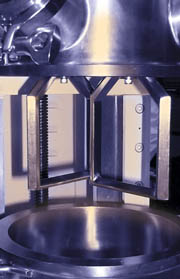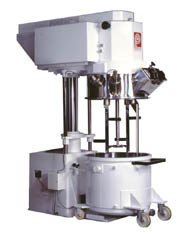
The customer's existing mixer configuration consisted of a rectangular gate-style planetary blade and an off-center mounted high-speed dispersion blade, along with a sidewall scraper. This mixing configuration caused the formation of large balls of un-wetted material, which created an unbalanced load for the mixer and caused excessive vibration and stress to the mixer drive. Eventually, the solids wetted out in the formulation, and it became a more uniform-looking heavy paste. However, this process took a long time (over 90 min.), and generated undesirable high product temperature in excess of 230ºF. In addition, the process was very complicated because the customer had to make a total of nine small powder additions at specific time intervals to prevent overloading of the mixer.
Our goal was to determine if the HIDROMIX mixing blade system was better suited to this type of material. The system features a finger-type planetary blade design with a center-mounted high-speed disperser. The finger-type blades are angled to provide a three-dimensional pumping action of materials (down from the top, up from the bottom, and horizontally around the tank) not possible with a standard rectangular-shaped gate style blade.
We hoped to prove the mixing system could produce the dental mold formulation without overloading, along with a lower final product temperature and a finished product that is smooth and lump free.
Mixing Procedure
The MPVDV-60 HIDROMIX machine, with a 60-L capacity, was used for batch testing. The vinyl-based liquid was the first material added to the mixing tank. In the first stage of mixing this formulation, fumed silica was added. This phase is crucial to making the finished product; it is very important to completely wet-out and disperse the fumed silica into the liquid vehicle. This fumed silica dispersion forms the foundation for the rest of the dental mold formula.Fumed silica has an extremely high surface area and is typically very difficult to wet out. It absorbs the liquid vehicle very quickly. When the first addition of fumed silica was made, the formulation took on a very dry appearance and the viscosity looked extremely high. As the fumed silica wet out, the viscosity began to drop and the product took on a more uniform paste-like appearance. During the entire fumed silica addition phase, the mixing unit did not show any signs of high load or stress, technicians did not observe any vibration, and there was no formation of any large balls of un-wetted product.
After the fumed silica was added, technicians stopped the mixer and raised the hood to inspect the product. This phase looked very uniform. The blades and shafts were scraped down to incorporate any dry powder clinging to the upper mixer housing (this is a normal step in the processing phase).
Technicians continued to add large quantities of filler material, and finally added the chemical additives and organic pigments to provide the finished color. The entire mixing process took 40 min. with a finished product temperature of 145ºF.
After a consistent batch appearance was achieved, the HIDROMIX unit was stopped and the hood was raised to inspect the material. The customer approved the quality of the finished dental mold compound and was satisfied that a uniform, lump-free product was created. After the batch was completed, technicians reviewed the process and determined that it was possible to reduce the number of additional steps.
A second batch of this dental mold compound was prepared with the mixing system using a streamlined procedure in which all ingredients were added in four steps instead of the previous nine. The product quality was equal to - if not better than - the previous batch.

Conclusion
The HIDROMIX mixing system proved to be superior to the customer's existing planetary/high-speed mixer. Premier Mill was able to simplify the customer's mixing process for this formula, thus eliminating several additional steps.The HIDROMIX blades prevent the formation of large lumps that can create an unbalanced condition that is common to other mixing designs. The blades also provide a three-dimensional product flow pattern. Material is constantly fed to the center-mounted high-speed dispersion blade without overloading.
The result of this testing was the purchase of an MPVDV-500 HIDROMIX machine with an electronic variable speed drive system and hydraulic ram discharge press system, which has been in successful operation for over three years.